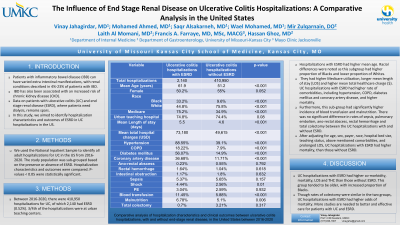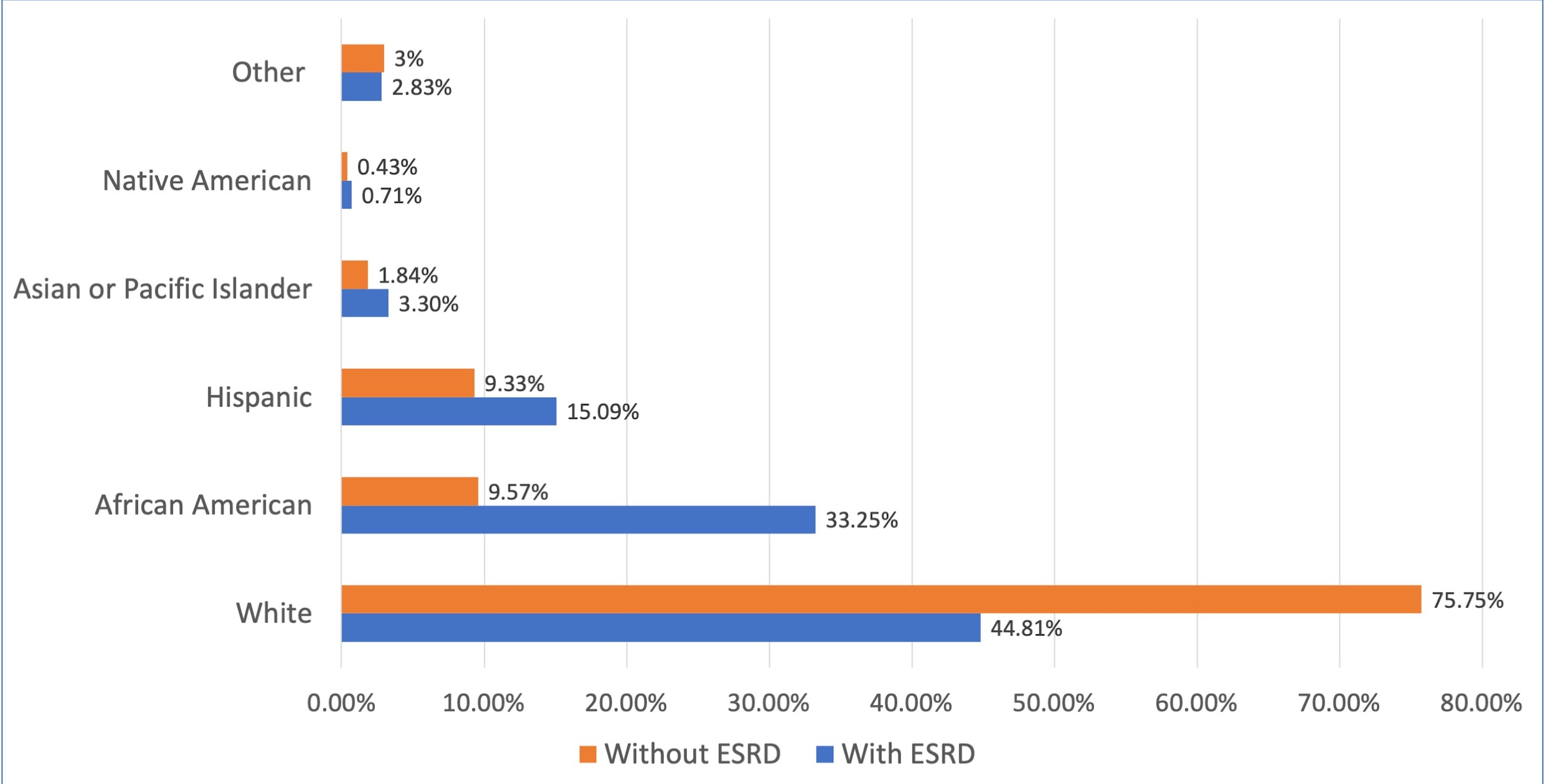Monday Poster Session
Category: IBD
P2126 - The Influence of End-Stage Renal Disease on Ulcerative Colitis Hospitalizations: A Comparative Analysis in the United States
Monday, October 23, 2023
10:30 AM - 4:15 PM PT
Location: Exhibit Hall

Has Audio
- MZ
Mir Zulqarnain, DO
University of Missouri-Kansas City
Kansas City, MO
Presenting Author(s)
Vinay Jahagirdar, MD1, Mohamed Ahmed, MD1, Saqr Alsakarneh, MD1, Wael Mohamed, MD1, Mir Zulqarnain, DO1, Laith Al Momani, MD2, Francis A. Farraye, MD, MSc, MACG3, Hassan Ghoz, MD1
1University of Missouri-Kansas City, Kansas City, MO; 2Northwestern University, Chicago, IL; 3Mayo Clinic, Jacksonville, FL
Introduction: Patients with inflammatory bowel disease (IBD) can have varied extra intestinal manifestations, with renal conditions described in 4%-23% of patients with IBD. IBD has also been associated with an increased risk of chronic kidney disease (CKD). Data on patients with ulcerative colitis (UC) and end stage renal disease (ESRD), where patients need dialysis, remains spars. In this study, we aimed to identify hospitalization characteristics and outcomes of ESRD in UC hospitalizations in the US.
Methods: We used the National Inpatient Sample to identify all adult hospitalizations for UC in the US from 2016-2020. The study population was sub-grouped based on the presence or absence of ESRD. Hospitalization characteristics and outcomes were compared. P-values < 0.05 were statistically significant.
Results: Between 2016-2020, there were 410,950 hospitalizations for UC, of which 2,140 had ESRD (0.52%). 3/4th of the hospitalizations were at urban teaching centers. Hospitalizations with ESRD had higher mean age (61.9 vs 51.18 years, p< 0.001). Racial differences were noted as this subgroup had higher proportion of Blacks (33.3% vs 9.6%, p< 0.001) and lower proportion of Whites (44.9% vs 75.8%, p< 0.001). They had higher Medicare utilization (75.2 % vs 34.9%, p< 0.001), longer mean length of stay [LOS] (5.5 vs 4.6, p< 0.001) and higher mean total healthcare charge ($73,180 vs $49,614, p< 0.001). UC hospitalizations with ESRD had higher rate of comorbidities, including hypertension, COPD, diabetes mellitus and coronary artery disease, and higher mortality (2.3% vs 0.3%, p< 0.001). Furthermore, this sub-group had significantly higher incidence of blood transfusion and malnutrition. There was no significant difference in rates of sepsis, pulmonary embolism, ano-rectal abscess, rectal hemorrhage and total colectomy between the UC hospitalizations with and without ESRD. After adjusting for age, sex, payer, race, hospital bed size, teaching status, above mentioned comorbidities, and prolonged LOS, UC hospitalizations with ESRD had higher mortality, than those without ESRD (OR 4.52, 95% CI 2.23-9.17).
Discussion: UC hospitalizations with ESRD had higher co-morbidity, mortality, LOS and THC than those without ESRD. This group tended to be older, with increased proportion of Blacks. Though rates of colectomy were similar in the two groups, UC hospitalizations with ESRD had higher odds of mortality. More studies are needed to better and effective care for patients with UC and ESRD.

Disclosures:
Vinay Jahagirdar, MD1, Mohamed Ahmed, MD1, Saqr Alsakarneh, MD1, Wael Mohamed, MD1, Mir Zulqarnain, DO1, Laith Al Momani, MD2, Francis A. Farraye, MD, MSc, MACG3, Hassan Ghoz, MD1. P2126 - The Influence of End-Stage Renal Disease on Ulcerative Colitis Hospitalizations: A Comparative Analysis in the United States, ACG 2023 Annual Scientific Meeting Abstracts. Vancouver, BC, Canada: American College of Gastroenterology.
1University of Missouri-Kansas City, Kansas City, MO; 2Northwestern University, Chicago, IL; 3Mayo Clinic, Jacksonville, FL
Introduction: Patients with inflammatory bowel disease (IBD) can have varied extra intestinal manifestations, with renal conditions described in 4%-23% of patients with IBD. IBD has also been associated with an increased risk of chronic kidney disease (CKD). Data on patients with ulcerative colitis (UC) and end stage renal disease (ESRD), where patients need dialysis, remains spars. In this study, we aimed to identify hospitalization characteristics and outcomes of ESRD in UC hospitalizations in the US.
Methods: We used the National Inpatient Sample to identify all adult hospitalizations for UC in the US from 2016-2020. The study population was sub-grouped based on the presence or absence of ESRD. Hospitalization characteristics and outcomes were compared. P-values < 0.05 were statistically significant.
Results: Between 2016-2020, there were 410,950 hospitalizations for UC, of which 2,140 had ESRD (0.52%). 3/4th of the hospitalizations were at urban teaching centers. Hospitalizations with ESRD had higher mean age (61.9 vs 51.18 years, p< 0.001). Racial differences were noted as this subgroup had higher proportion of Blacks (33.3% vs 9.6%, p< 0.001) and lower proportion of Whites (44.9% vs 75.8%, p< 0.001). They had higher Medicare utilization (75.2 % vs 34.9%, p< 0.001), longer mean length of stay [LOS] (5.5 vs 4.6, p< 0.001) and higher mean total healthcare charge ($73,180 vs $49,614, p< 0.001). UC hospitalizations with ESRD had higher rate of comorbidities, including hypertension, COPD, diabetes mellitus and coronary artery disease, and higher mortality (2.3% vs 0.3%, p< 0.001). Furthermore, this sub-group had significantly higher incidence of blood transfusion and malnutrition. There was no significant difference in rates of sepsis, pulmonary embolism, ano-rectal abscess, rectal hemorrhage and total colectomy between the UC hospitalizations with and without ESRD. After adjusting for age, sex, payer, race, hospital bed size, teaching status, above mentioned comorbidities, and prolonged LOS, UC hospitalizations with ESRD had higher mortality, than those without ESRD (OR 4.52, 95% CI 2.23-9.17).
Discussion: UC hospitalizations with ESRD had higher co-morbidity, mortality, LOS and THC than those without ESRD. This group tended to be older, with increased proportion of Blacks. Though rates of colectomy were similar in the two groups, UC hospitalizations with ESRD had higher odds of mortality. More studies are needed to better and effective care for patients with UC and ESRD.

Figure: Comparative analysis of racial distribution for ulcerative colitis hospitalizations, with and without end-stage renal disease, in the United States from 2016-2020
Disclosures:
Vinay Jahagirdar indicated no relevant financial relationships.
Mohamed Ahmed indicated no relevant financial relationships.
Saqr Alsakarneh indicated no relevant financial relationships.
Wael Mohamed indicated no relevant financial relationships.
Mir Zulqarnain indicated no relevant financial relationships.
Laith Al Momani indicated no relevant financial relationships.
Francis Farraye: AbbVie – Advisory Committee/Board Member. Avalo Therapeutics – Advisory Committee/Board Member. BMS – Advisory Committee/Board Member. Braintree Labs – Advisory Committee/Board Member. Fresenius Kabi – Advisory Committee/Board Member. GI Reviewers – Independent Contractor. GSK – Advisory Committee/Board Member. IBD Educational Group – Independent Contractor. Iterative Health – Advisory Committee/Board Member. Janssen – Advisory Committee/Board Member. Pfizer – Advisory Committee/Board Member. Pharmacosmos – Advisory Committee/Board Member. Sandoz Immunology – Advisory Committee/Board Member. Sebela – Advisory Committee/Board Member. Viatris – Advisory Committee/Board Member.
Hassan Ghoz indicated no relevant financial relationships.
Vinay Jahagirdar, MD1, Mohamed Ahmed, MD1, Saqr Alsakarneh, MD1, Wael Mohamed, MD1, Mir Zulqarnain, DO1, Laith Al Momani, MD2, Francis A. Farraye, MD, MSc, MACG3, Hassan Ghoz, MD1. P2126 - The Influence of End-Stage Renal Disease on Ulcerative Colitis Hospitalizations: A Comparative Analysis in the United States, ACG 2023 Annual Scientific Meeting Abstracts. Vancouver, BC, Canada: American College of Gastroenterology.
